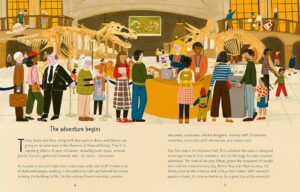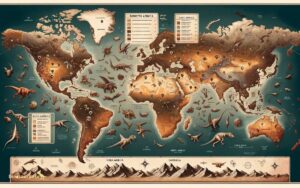When Was the Last Dinosaur
Contrary to popular belief, not all dinosaurs vanished at the end of the Cretaceous period; their legacy persists in the birds that grace our skies today.
The last non-avian dinosaurs, which roamed the earth about 66 million years ago, met their end under circumstances that continue to fuel scientific debate and fascination.
Unraveling the story of their extinction involves piecing together clues from ancient rocks, fossils, and a bit of cosmic detective work.
Join us as we explore the intricate tapestry of theories and discoveries that shed light on this prehistoric puzzle, and perhaps, reveal insights into our own survival on this ever-changing planet.
Key Takeaways
- The last dinosaurs lived around 66 million years ago before a catastrophic asteroid impact.
- Fossil records identify Triceratops and Tyrannosaurus rex among the final dinosaurs.
- Radiometric dating of fossils places these species right up to the Cretaceous-Paleogene boundary.
- The sudden extinction of dinosaurs was likely due to the combined effects of asteroid impact and volcanic activity.
The Mesozoic Era Explained
Spanning approximately 186 million years, the Mesozoic Era, often termed the 'Age of Reptiles,' marks a pivotal period in Earth's history when dinosaurs dominated the land, sea, and air.
This era, divided into three periods: the Triassic, Jurassic, and Cretaceous, witnessed the evolution, flourishing, and diversification of these reptiles. In the Triassic period, the first dinosaurs emerged, adapting to a wide range of ecological niches.
By the Jurassic period, they'd become the planet's predominant terrestrial vertebrates, showcasing an incredible variety in size, form, and dietary preference.
The Cretaceous period saw further diversification, including the evolution of flowering plants and the first birds. Throughout the Mesozoic, the Earth's continents gradually shifted from a single supercontinent towards their present positions, influencing evolutionary paths and the distribution of dinosaur species.
Timeline of Dinosaur Extinction
The timeline of dinosaur extinction is marked by a pivotal event approximately 66 million years ago, when a catastrophic asteroid impact triggered a mass extinction. This event eradicated nearly 75% of Earth's species, including the majority of dinosaurs, setting the stage for mammalian dominance.
Analysis of surviving species evidence and the mass extinction timeline offers critical insights into the causes of extinction and the resilience of life on Earth.
Causes of Extinction
Dinosaurs faced extinction approximately 66 million years ago due to a combination of catastrophic events. This period, marking the end of the Cretaceous, saw a drastic shift in Earth's climate and ecosystems. The asteroid, believed to have struck near what's now the Yucatan Peninsula, created global darkness, cooling, and a dramatic decrease in photosynthesis. This event alone significantly altered the planet's living conditions.
Concurrently, the Deccan Traps, a large volcanic province in present-day India, spewed vast amounts of lava and gases into the atmosphere, exacerbating climate change. These geological and extraterrestrial forces combined to create a hostile environment unsuitable for dinosaur life, leading to their eventual extinction.
Mass Extinction Timeline
Understanding the causes of extinction sets the stage for exploring the timeline of dinosaur disappearance, which unfolded over several millennia at the end of the Cretaceous period. The sequence of events leading to the mass extinction of dinosaurs is complex, involving a combination of environmental changes and catastrophic events.
- Approximately 66 million years ago: A massive asteroid impacts Earth, creating the Chicxulub crater in present-day Mexico.
- Immediate Aftermath: The impact generates global firestorms, tsunamis, and ejects vast amounts of dust and soot into the atmosphere.
- Months to Years Following Impact: Reduced sunlight leads to a 'nuclear winter' scenario, significantly disrupting photosynthesis and cooling the planet.
- Long-term Effects: The altered climate and ecosystems result in the extinction of three-quarters of Earth's plant and animal species, including all non-avian dinosaurs.
Surviving Species Evidence
Amid the catastrophic events that led to the mass extinction of dinosaurs, evidence suggests a select few species managed to survive, adapting to the drastically changed ecosystems. Researchers have meticulously analyzed fossil records, uncovering clues that point towards the existence of avian dinosaurs – the ancestors of modern birds – as the primary survivors.
This transition illustrates a remarkable evolutionary adaptation, showcasing how these species evolved to exploit new ecological niches. The fossil evidence, marked by changes in bone structure and feather adaptations, supports the theory that these avian descendants were better equipped to survive in the post-extinction environment.
Their ability to fly, for instance, provided them with a significant advantage, enabling access to new habitats and resources, thus ensuring their survival and the continuation of the dinosaur lineage in a new form.
The Cretaceous-Paleogene Boundary
Approximately 66 million years ago, the Cretaceous-Paleogene Boundary marked a pivotal moment in Earth's history, signifying the abrupt end of the Mesozoic Era and the extinction of three-quarters of the planet's plant and animal species. This boundary isn't only a timestamp but also a demarcation of profound biological and environmental shifts.
- Global Biodiversity Loss: The immediate aftermath saw the disappearance of many marine and terrestrial species, including all non-avian dinosaurs.
- Geological Evidence: Layers of sedimentary rock across the globe contain a distinct layer of iridium, rare on Earth but common in asteroids.
- Rapid Environmental Changes: Fossil records indicate a sudden shift in plant and animal populations, signaling drastic changes in climate and habitat.
- Survival and Evolution: This event paved the way for the rise of mammals, including humans, dominating the planet in the ensuing eras.
Causes of Dinosaur Extinction
Exploring the causes of dinosaur extinction reveals a complex interplay of catastrophic events and environmental upheavals following the Cretaceous-Paleogene Boundary. Scientists have pinpointed a massive asteroid impact in what's now the Yucatán Peninsula as a primary catalyst. This event unleashed global firestorms, followed by a 'nuclear winter' scenario, drastically cooling the planet.
Additionally, the impact triggered volcanic eruptions across the Deccan Traps, further spewing greenhouse gases into the atmosphere. This one-two punch not only altered the climate but also significantly reduced sunlight penetration, disrupting photosynthesis. It's believed these combined factors decimated plant and animal food sources, leading to a cascading effect of extinction.
This period marked a pivotal moment in Earth's history, signifying the end of the age of dinosaurs and paving the way for mammalian dominance.
Discoveries in Paleontology
Recent fossil discoveries have significantly advanced our understanding of dinosaur extinction and the broader field of paleontology.
These findings haven't only brought new theories to light regarding how dinosaurs met their end but have also reshaped the evolution of paleontology as a science.
Such advancements underscore the dynamic nature of research in this field, continually refining our comprehension of ancient life on Earth.
Recent Fossil Discoveries
Paleontology's landscape has been significantly reshaped by groundbreaking fossil discoveries, offering new insights into the ancient world of dinosaurs. These recent finds haven't only expanded our understanding but also challenged previous theories about dinosaur behavior, evolution, and their environment.
To illustrate, consider the following:
- New Species Identification: Scientists have identified previously unknown species, revealing a greater diversity in dinosaur types and sizes than was once understood.
- Feathered Dinosaurs: Discoveries of feathered dinosaurs in China have provided concrete evidence of the connection between dinosaurs and birds.
- Nesting Behaviors: Fossilized nests and eggs have offered a glimpse into the reproductive strategies and parental care of dinosaurs.
- Growth Patterns: Analysis of bone structures has led to new theories on how fast dinosaurs grew and how their metabolism functioned.
These discoveries represent pivotal moments in paleontological research, deepening our comprehension of these ancient creatures.
Dinosaur Extinction Theories
Building on our understanding of dinosaur diversity and behavior, scientists have also made significant strides in unraveling the mysteries behind their extinction. Central to the discourse is the asteroid impact theory, positing a colossal collision about 66 million years ago, creating a global layer of iridium—an element rare on Earth's surface but abundant in asteroids. This event likely triggered a catastrophic chain reaction: wildfires, a 'nuclear winter,' and subsequent cooling that drastically altered Earth's climate.
Concurrently, volcanic activity in what's now India, the Deccan Traps, compounded these environmental stresses, spewing vast amounts of lava and noxious gases. These theories don't stand alone but interlink, suggesting a multifaceted cataclysm that dismantled the once-dominant dinosaur ecosystem, paving the way for mammalian ascendance.
Evolution of Paleontology
Over the years, discoveries in paleontology have profoundly shaped our understanding of life's history on Earth, revealing intricate details about the organisms that once roamed our planet.
- Fossil Discoveries: Advanced technologies like CT scanning have unveiled the internal structures of fossils, allowing scientists to study ancient creatures' anatomy and evolution with unprecedented precision.
- Molecular Paleontology: The extraction and analysis of ancient DNA and proteins have revolutionized our ability to trace lineage and evolutionary paths, connecting dots between species thought to be unrelated.
- Digital Reconstruction: 3D modeling and virtual reality have enabled paleontologists to reconstruct and interact with extinct organisms and ecosystems, providing new insights into their behaviors and environments.
- Interdisciplinary Approaches: Combining geological and paleontological data has led to a more nuanced understanding of how Earth's changing climates shaped the evolution of life, offering a more dynamic picture of the past.
The Last Dinosaurs Identified
Identifying the last dinosaurs before their mass extinction involves analyzing fossil records from the late Cretaceous period with meticulous precision. Scientists concentrate on the stratigraphic layers closest to the K-Pg boundary, the geological demarcation marking the end of the Cretaceous period.
This approach has led to the identification of species such as Triceratops and Tyrannosaurus rex as among the final dinosaurs roaming Earth. Their remains, found in North America, suggest a diverse ecosystem existed just before the mass extinction event.
Advanced radiometric dating techniques and sediment analysis provide a chronological framework, pinpointing these species' existence up to the boundary. This evidence supports the theory that dinosaurs were thriving until a sudden catastrophic event led to their demise, excluding factors like gradual decline or significant evolutionary changes pre-extinction.
The Role of Asteroids
While the existence of dinosaurs up to the K-Pg boundary is well-documented, the catastrophic impact of an asteroid at this juncture played a pivotal role in their sudden extinction.
- Massive Impact: An asteroid approximately 10 kilometers in diameter struck the Earth, creating the Chicxulub crater in what's now the Yucatán Peninsula.
- Global Firestorms: The collision released an immense amount of energy, igniting wildfires across vast areas, which decimated the dinosaurs' habitats.
- Dust Cloud: Particulates from the impact blocked sunlight, significantly reducing photosynthesis and leading to a drastic drop in global temperatures.
- Food Chain Collapse: With plants dying off, herbivorous dinosaurs lost their food source, followed by carnivorous dinosaurs who preyed on them, culminating in a mass extinction event.
Climate Change Effects
The aftermath of the asteroid's collision led to significant climate change effects, drastically altering Earth's ecosystems and further challenging the survival of species that had withstood the initial impact.
The collision propelled millions of tons of dust, ash, and debris into the atmosphere, blocking sunlight for years. This sudden darkness led to a dramatic drop in global temperatures, a phenomenon known as an 'impact winter.' Photosynthesis, the bedrock of the food chain, was severely hindered, causing widespread plant die-offs. Consequently, herbivores faced food shortages, leading to a cascading effect up the food chain.
Additionally, the release of sulfur compounds into the atmosphere resulted in acid rain, damaging terrestrial and aquatic habitats. These adverse conditions created a hostile environment, making adaptation or migration essential for survival.
Survival and Evolution
Despite the harsh conditions following the asteroid's impact, some species managed to survive and embark on a path of evolution, adapting to the drastically changed ecosystems. These survivors, through a process of natural selection, gave rise to a diversity of life forms that populate the Earth today. Their survival and evolutionary journey can be broken down into several key phases:
- Immediate Survival: Small, adaptable species with the ability to find shelter and sustenance in post-impact environments thrived.
- Radiation: Following the initial survival phase, these species diversified into a multitude of forms.
- Adaptation: These organisms adapted to the new niches and ecosystems that emerged.
- Speciation: Over millions of years, this process led to the speciation and the rich biodiversity we observe today.
Recent Fossil Discoveries
Recent fossil discoveries have significantly expanded our understanding of post-impact ecosystems and the creatures that inhabited them. Researchers have unearthed evidence suggesting a rapid diversification of species after the mass extinction event, challenging previous notions of a slow recovery.
These findings include remarkably well-preserved specimens of small mammals, insects, and early birds, providing a clearer picture of the ecological dynamics during this period. Advanced dating techniques and detailed morphological analyses have enabled scientists to pinpoint the survival strategies these species employed.
For instance, some adapted to new niches left vacant by the dinosaurs, while others developed unique dietary habits or physical traits. These discoveries not only refine our comprehension of life's resilience but also offer insights into the mechanisms of evolution in the face of catastrophic events.
Exploring Extinction Theories
Scientists have posited several theories to explain the mass extinction event that marked the end of the dinosaurs. The impact event hypothesis suggests a colossal asteroid collision played a pivotal role, while others argue that volcanic activity underpinned the dinosaurs' demise.
These theories offer insights into the complex interplay between extraterrestrial impacts and terrestrial forces in shaping Earth's biological history.
Theories Behind Mass Extinction
How did the reign of the dinosaurs come to an abrupt end over 65 million years ago? Scientists have proposed several theories, each shedding light on possible catastrophic events that could have led to this mass extinction. Exploring these theories offers a glimpse into Earth's volatile past and the fragility of life.
- Volcanic Activity: Massive volcanic eruptions could have released vast amounts of ash and gases into the atmosphere, significantly altering the climate.
- Climate Change: Gradual but significant shifts in Earth's climate could have disrupted dinosaurs' habitats, leading to a decline in food sources.
- Disease: Epidemics might've spread rapidly among dinosaur populations, weakening them significantly.
- Competition from Mammals: The rise of mammals could have led to increased competition for resources, gradually edging dinosaurs out of existence.
Impact Event Hypothesis
Among the theories explaining the sudden disappearance of dinosaurs over 65 million years ago, the impact event hypothesis posits that a colossal asteroid collision with Earth triggered a global environmental catastrophe.
This hypothesis, supported by a layer of iridium-rich sediment worldwide and a massive crater off the coast of Mexico, suggests that the impact hurled vast amounts of dust and debris into the atmosphere. This, in turn, led to a significant decrease in sunlight reaching the Earth's surface, drastically lowering temperatures and disrupting photosynthesis.
The resultant chain reaction would've decimated plant life, subsequently starving herbivorous dinosaurs and, by extension, their carnivorous predators. The hypothesis underscores a rapid, devastating effect on Earth's climate and ecosystems, aligning with the abrupt end to the dinosaur era.
Volcanic Activity Role
While the impact event hypothesis provides a compelling explanation for the dinosaurs' extinction, volcanic activity also played a crucial role, as evidenced by extensive lava flows and ash deposits from the same period.
- Volume and Distribution: Massive lava flows, such as those from the Deccan Traps in India, covered thousands of square kilometers, altering global climate patterns significantly.
- Atmospheric Impact: The release of sulfur and carbon dioxide from these eruptions could have drastically altered the Earth's atmosphere, leading to cooling or warming effects.
- Biological Consequences: Acid rain and significant changes in ocean chemistry would have severely impacted food chains, affecting both marine and terrestrial ecosystems.
- Temporal Correlation: The timing of these volcanic events closely aligns with the period of mass extinction, suggesting a synergistic effect with the impact event in driving the dinosaurs to extinction.
Conclusion
In the twilight of the Mesozoic Era, the ancient giants met their silent dusk. The Cretaceous-Paleogene boundary marks this profound transition, where celestial fury and Earth's own upheavals weaved the tapestry of extinction.
Recent paleontological discoveries peel back layers of time, revealing the intricate dance of survival and evolution. As we unearth these buried narratives, the saga of dinosaur demise offers poignant insights into climate dynamics and Earth's resilience, guiding our understanding of life's fragile persistence amidst cosmic caprices.




